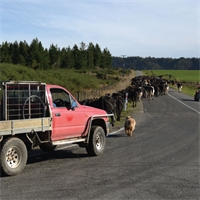17Aug
The benefits of Magnesium
THIS PROMOTIONAL FEATURE WAS PROVIDED BY BALLANCE AGRI-NUTRIENTS
Magnesium is an essential nutrient for the process of photosynthesis (the plant’s ability to turn light into energy). The element magnesium is used in the production of chlorophyll which is at the heart of photosynthesis. Chlorophyll molecules give plants their green colour, and when photosynthesis is affected, their leaves become paler.
General farming practices of livestock grazing, and crop harvesting removes magnesium from the soil. However, magnesium can also be lost from soil through other processes such as leaching. Wet conditions can enable magnesium to leach from the soil. Furthermore, so do high levels of calcium or potassium in the soil. When high rates of calcium are applied to the soil from the likes of superphosphate or lime, magnesium can be displaced from the soil colloid (surface) and into soil solution (the water in the soil) where, if it is not taken up by plants, can be at risk of leaching. High rates of potassium can have a similar effect on magnesium levels.
If magnesium is not replaced, magnesium levels can decrease, and deficiencies may start to appear in older growth. Leaves of plants with low magnesium appear marbled (yellow/pale green in colour) while veins remain green. Quick Test Magnesium (QT Mg) measures the amount of magnesium that is readily available for plant uptake. The target range for plant growth is QT Mg 8 to 10. When soil levels drop below the target range, pasture production can become limited. When magnesium levels need to be raised, an average of 7kg Mg/ha can be applied to raise soil QT Mg levels by one unit, over and above maintenance requirements.
Ideal magnesium fertilisers release magnesium for an extended period and at the rate needed for either plant growth and/or animal nutrition. For pasture, this is for one or more years with minimal leaching losses. Serpentine Super is a useful product that combines serpentine rock with superphosphate, and the acid used in the manufacturing process makes some of the serpentine rock’s magnesium more soluble and therefore plant available. This means 70 percent of the total magnesium in Serpentine Super is released in the first 12 to 24 months.
In a Fertilizer and Lime Research Centre study1 Serpentine Super was applied at a rate of 100 kg Mg/ha and herbage magnesium levels measured over 30 months. Around 43 percent of the magnesium was in the topsoil by day 282 and 67 percent by day 856. Even 30 months after application, the Serpentine Super was still releasing magnesium for plant uptake, as indicated by the levels of dissolved and partially dissolved magnesium in the topsoil. Herbage from plots treated with Serpentine Super contained 57 percent more magnesium than herbage from control plots which received no application of magnesium.
Vital for stock
Stock cannot store magnesium, so they need a daily intake from feed. Magnesium deficiency in stock can affect production even if the clinical signs of deficiency, such as grass staggers or tetany (hypomagnesaemia), are not apparent.
The target range in soil for stock health is QT Mg 25 to 30. However, herbage testing is the best way to check how much magnesium stock are getting from pasture. Pasture magnesium concentrations vary seasonally and are naturally lowest in spring when animals most need the mineral. As calcium and potassium can decrease magnesium uptake by pasture and its availability to grazing stock, application in the two months prior to calving is best avoided.
It can be difficult to raise soil magnesium levels high enough to protect animals from deficiency before and during calving, so additional magnesium supplementation may be needed. Options to help add magnesium to their diet can be done through drenching, dosing drinking water or dusting feed.
¹ P. Loganathan, J. A. Hanly & L. D. Currie (2005) Effect of serpentine rock and its acidulated products as magnesium fertilisers for pasture, compared with magnesium oxide and Epsom salts, on a Pumice Soil. 2. Dissolution and estimated leaching loss of fertiliser magnesium, New Zealand Journal of Agricultural Research, 48:4, 461-471
Related

Rooted in generations of family, Lawn Hayes is a testament to the innovative and questioning spirit ...
Read More

This year’s Ruralco Instore Days will be held on Thursday 7 July and Friday 8 July, with deals avai...
Read More

In the past months, the ability of New Zealanders to access and afford quality fresh food has been i...
Read More

Staying local and true to its original intent is Ruralco’s primary focus for its future strategy.
Read More

Now more than ever, farmers are reliant on technology to assist in every day farming decisions.
Read More

For many people around the world, farewelling 2020 came with the hope that 2021 would somehow bring ...
Read More